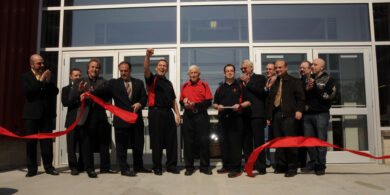Trying to define race-ready – October 16, 2006
Riding the coattails of a larger ATV market and the growing popularity of quad racing, more manufacturers are releasing sports models that are being labeled “race-ready.”
Aside from the different forms of racing, which require vastly different components and setups, manufacturers are using differing definitions of what makes a four-wheeler truly ready to hit the track.
The name game started with Suzuki, which started the phenomenon with its 2006 LT-R450. The company’s branding says the model was built for racing with the help of WPSA motocross champion Doug Gust.
Kawasaki and KTM, both releasing highly anticipated sport quads in 2007, also are saying their new models are race-ready, but will have significant differences in features and price.
With more manufacturers joining the racing fray, the definition of stock racing machines has become more obscure.
For professional motocross racing, most teams add protective nerf bars, custom lightweight and durable handlebars, a steering stem, upgraded wheels and tires, exhaust and suspension modifications and a kill switch. Furthermore, removing the front headlight, exhaust baffle and airbox lid are standard practices to cut weight and improve performance.
Kawasaki, whose upcoming KFX450R will be released as a 2008 model, “doesn’t require extensive and expensive modifications to make it race-ready,” according to press information. Company officials said the new quad will be competitively priced within the 450 class.
When pressed for a more specific definition of race capable, company officials said the new KFX should be viewed more as a racing platform.
“Race capability was right at the forefront of our development effort for this project,” said Vince Iorio, Kawasaki’s product manager. “I think race ready is maybe a bit incorrect descriptor to some degree, at least the way we see it. We see our product as being totally race capable.”
That means delivering a platform to consumers that can be easily modified to competition standards, he said.
But, like the Suzuki LT-R, modifications to suspension, exhaust and engine components would likely be necessary for professional competition.
At KTM, whose corporate slogan is “Ready to Race,” that means building a machine that is priced “quite a bit higher,” but designed with the intention that a racer would need to add or remove very little before entering professional competition.
“There’s no reason to buy the bike and change stuff unless you’re personalizing it to your own riding style or grip preference,” KTM media relations manager Tom Moen said. “What we’re competing against is the race-ready quads. We’re not building a platform for a guy to spend another $10,000 to $20,000 on.”
He added the motocross racing sport has taken off and that more tracks are opening up to the general public, increasing racing’s influence on consumers.
KTM sees its pair of upcoming quads, 450- and 525cc models, creating a new, more specialized segment of the market. Moen said the company designed its quads to compete against fully race-modified models, rather than stock products from the competition.
Yamaha’s current YFZ and Honda’s 450 are both popular in various racing series and originally debuted as 2004 models. Both require extensive competition modifications for professional racing, like the Suzuki and upcoming Kawasaki quads.
No information was available as of press time on when those models are slated for replacement. psb




